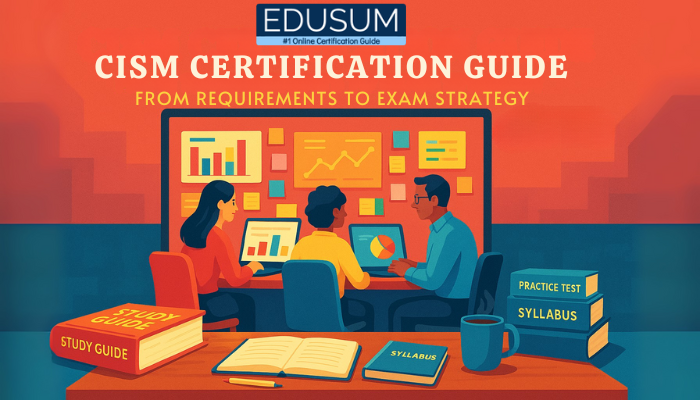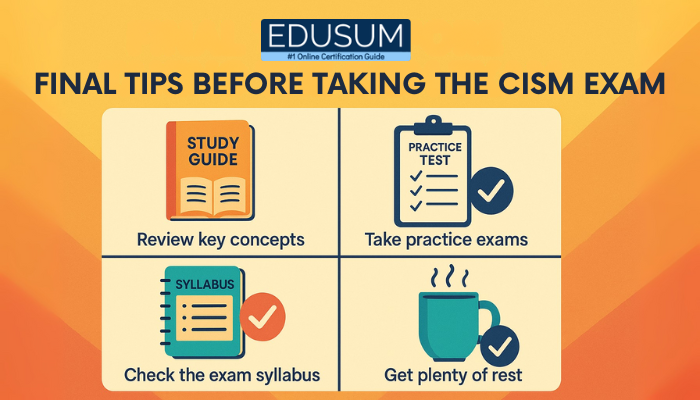
The cybersecurity landscape is constantly evolving, demanding professionals with advanced skills in managing and governing information security programs. The CISM certification (Certified Information Security Manager) offered by ISACA stands out as a globally recognized credential for experienced security professionals and those aspiring to leadership roles. This comprehensive guide will take you beyond the basics of the CISM certification, providing an in-depth look at its requirements, the exam structure, effective preparation strategies, and resources to help you succeed. Whether you are a seasoned practitioner, a student aiming for a cybersecurity career, or an employer looking to validate your team's expertise, understanding the nuances of the CISM cert is crucial.
What is CISM Certification?
The ISACA CISM certification is designed for individuals who manage, design, oversee, and assess an enterprise’s information security. It validates expertise in information security governance, risk management, program development and management, and incident management. Unlike more technically focused certifications, CISM emphasizes the strategic and business aspects of information security. Obtaining the CISM certification signifies that you possess the knowledge and experience to develop and manage an enterprise-wide information security program. For employers and job seekers alike, the CISM acts as a benchmark of competence and a differentiator in a competitive job market. The value of the AI-102 certification worth it is often discussed in similar professional circles, but for those focused on management, CISM holds significant weight.
CISM Certification Requirements
Before embarking on your journey to achieve the CISM certification, it’s essential to understand the prerequisites set by ISACA. These requirements ensure that candidates have a foundational level of experience necessary to effectively apply the knowledge gained through the certification process. The key CISM certification requirements include:
-
Experience: Candidates must have a minimum of five years of professional information security work experience, with at least three years in a management role within the specific domains of the CISM exam. This practical experience is critical for understanding and applying the concepts covered in the certification.
-
Examination: You must successfully pass the CISM exam. This rigorous examination tests your knowledge and understanding of the four core domains of information security management.
-
Application: After passing the exam and meeting the experience requirements, you need to formally apply for certification with ISACA. This involves submitting an application and adhering to ISACA’s Code of Professional Ethics.
-
Continuing Professional Education (CPE): To maintain your CISM cert, you must adhere to ISACA’s CPE policy. This involves earning and reporting a specific number of CPE credits annually, ensuring your skills and knowledge remain current.
CISM Exam Structure & Key Topics
Understanding the structure and key topics of the CISM exam is crucial for effective preparation. The CISM test is a challenging assessment designed to evaluate your competency across the four domains of information security management. Here’s a breakdown of the CISM exam structure and the key topics within each domain:
-
Exam Name: ISACA Certified Information Security Manager (CISM)
-
Exam Code: CISM
-
Duration: 240 minutes
-
Number of Questions: 150 multiple-choice questions
-
Passing Score: 450 out of 800 points
The CISM exam focuses on the following four domains:
1. Information Security Governance (17%):
This domain covers the establishment and maintenance of a framework to provide assurance that information security strategies are aligned with and support business objectives, consistent with applicable laws and regulations. Key topics include:
-
Establishing and maintaining an information security strategy and supporting policies.
-
Ensuring accountability and responsibility for information security.
-
Integrating information security governance into enterprise governance.
-
Monitoring and evaluating the effectiveness of the information security governance framework.
2. Information Security Risk Management (20%):
This domain addresses the identification, assessment, evaluation, and treatment of information security risks in a manner that supports business objectives. Key topics include:
-
Establishing and maintaining an overall risk management program.
-
Conducting risk assessments to identify threats and vulnerabilities.
-
Evaluating and classifying risks based on their potential impact and likelihood.
-
Developing and implementing risk treatment plans and monitoring their effectiveness.
3. Information Security Program (33%):
This is the most heavily weighted domain and focuses on the establishment, development, and management of an information security program to implement the information security strategy and in accordance with business objectives. Key topics include:
-
Developing and maintaining information security policies, standards, and procedures.
-
Acquiring, implementing, and managing information security resources and technologies.
-
Promoting information security awareness and training.
-
Monitoring and reporting on information security program performance.
4. Incident Management (30%):
This domain covers the planning, preparation, and execution of activities to detect, analyze, contain, eradicate, recover from, and learn from information security incidents. Key topics include:
-
Developing and maintaining an incident response plan.
-
Establishing procedures for detecting, analyzing, and escalating security incidents.
-
Managing and coordinating the response to information security incidents.
-
Conducting post-incident reviews and implementing lessons learned.
Understanding these domains and their respective weightings will help you focus your study efforts effectively for the CISM test exam.
CISM Practice Exam and Mock Test Resources
Preparing for the CISM exam requires dedication and the use of effective study resources. Taking CISM practice exams and CISM mock tests is an invaluable part of this preparation. These resources help you familiarize yourself with the exam format, identify your strengths and weaknesses, and build confidence. Consider utilizing resources like those available at Edusum, which offer targeted practice exams designed to simulate the actual CISM test exam.
-
Official ISACA Resources: ISACA offers official study materials, practice questions, and review courses. These are highly recommended as they are directly aligned with the exam content and format. You can find more information on the official ISACA website: ISACA CISM.
-
Third-Party Practice Exams: Numerous third-party providers offer CISM practice tests, CISM mock tests, and CISM practice questions. These can provide additional perspectives and help reinforce your understanding of the concepts. Websites like Edusum often provide realistic exam simulations.
-
Study Groups and Forums: Engaging with other professionals preparing for the CISM can be beneficial. Sharing experiences, discussing challenging topics, and learning from each other can enhance your understanding. Look for online forums or local ISACA chapter study groups.
-
Review Courses: Consider enrolling in a CISM exam review course. These courses are typically led by experienced instructors and provide a structured approach to covering the exam content.
By consistently practicing with CISM practice questions and simulated exams, you can significantly improve your chances of success on the actual CISM exam. Remember to analyze your results, identify areas where you need to improve, and revisit the relevant study materials. The experience gained from taking a cism practice test is invaluable in reducing exam-day anxiety and improving your time management skills during the actual cism test.
Final Tips Before Taking the CISM Test Exam
As you approach your CISM test exam date, here are some final tips to help you perform your best:
-
Review Key Concepts: Spend the final days reviewing the key concepts and principles from each of the four CISM domains. Focus on understanding the "why" behind the processes and procedures.
-
Take a Final Mock Test: Simulate the actual exam conditions by taking a full-length CISM mock test. This will help you gauge your readiness and identify any remaining areas of weakness.
-
Manage Your Time: During the exam, pace yourself and manage your time effectively. Don't spend too long on any single question. If you're unsure of an answer, make your best guess and move on. You can always return to it later if you have time.
-
Read Questions Carefully: Ensure you understand what each question is asking before attempting to answer. Pay attention to keywords and any qualifiers in the question.
-
Stay Calm and Confident: On the day of the exam, try to stay calm and confident. Trust in the preparation you have done. Get a good night's rest before the exam and arrive at the testing center with plenty of time.
FAQs
Q1. What is the cost of the CISM certification exam?
-
The Certified Information Security Manager CISM cost is $575 (USD) for ISACA members and $760 (USD) for non-members.
Q2. How long is the CISM certification valid for?
-
The CISM cert is valid for three years from the date of certification. To maintain it, you need to earn and report at least 120 Continuing Professional Education (CPE) hours during this period and pay an annual maintenance fee.
Q3. Is the CISM certification worth it?
-
For experienced information security professionals looking to move into management roles, the CISM certification is highly valuable. It is widely recognized and respected within the industry, often leading to better job opportunities and higher salaries. The "worth" of the AI-102 certification worth it might be a question for those in AI, but for security management, CISM is a strong contender.
Q4. What are the prerequisites for the CISM exam?
-
To be eligible for the CISM exam, you need at least five years of professional information security work experience, with a minimum of three years in a management role across the CISM domains.
Q5. Where can I find CISM practice questions and mock tests?
-
You can find CISM practice questions, CISM test exams, and CISM practice tests on the official ISACA website and various third-party providers like Edusum.
Conclusion
The CISM certification is a significant achievement that can elevate your career in information security management. By understanding the CISM certification requirements, the CISM exam structure, and by utilizing effective preparation strategies and resources like CISM practice exams from Edusum, you can significantly increase your chances of success. Remember that the journey to becoming a Certified Information Security Manager requires dedication and perseverance. Embrace the challenge, stay focused on your goal, and leverage the resources available to you. Your commitment to mastering the principles of information security governance, risk management, program development, and incident management will not only lead to the prestigious CISM cert but also contribute to a more secure digital world.
We believe in your ability to succeed – start your preparation today!

